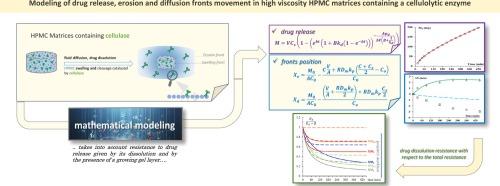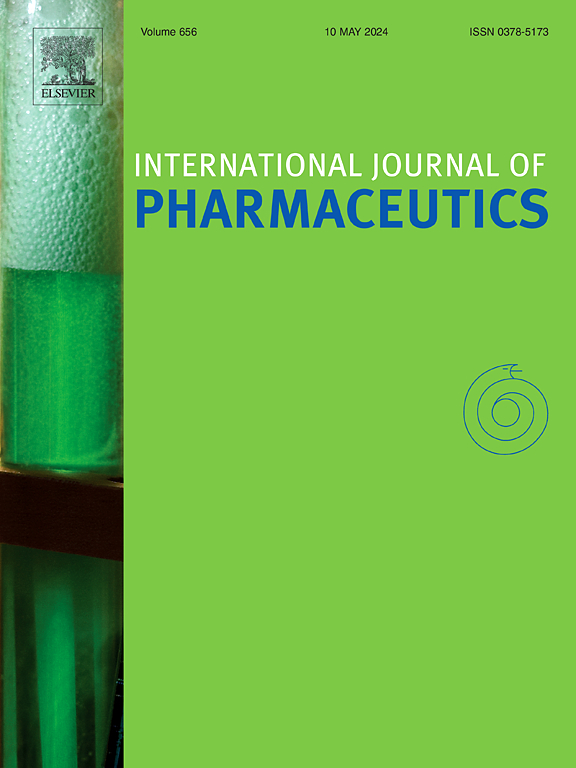Modeling of drug release, erosion and diffusion fronts movement in high viscosity HPMC matrices containing a cellulolytic enzyme
IF 5.3
2区 医学
Q1 PHARMACOLOGY & PHARMACY
引用次数: 0
Abstract
A formerly developed mathematical model describing drug release from hydrophilic matrices (HMs) took into account resistance to drug release given by its dissolution and by the presence of a growing gel layer. Such a model was applied to previously reported release data obtained from HMs made of hydroxypropyl methylcellulose (HPMC), where acetaminophen was used as model drug and a cellulolytic product was added as “active” excipient to attain zero-order release kinetics. The Levich theory applied to acetaminophen intrinsic dissolution rate (IDR) data highlighted the suitability of such a drug for modeling purposes, given its good surface wettability. First assessment of the model ability to describe drug release from the abovementioned systems was carried out on partially coated matrices, representing a simplified physical frame, but results were then confirmed on uncoated systems. Experimental and model release data showed good agreement; therefore, the release-describing equation was combined with that of the global mass balance to obtain two new equations related to erosion and diffusion fronts time evolution. Changes over time in the dissolution and gel contributions to total resistance, calculated using model output parameters, highlighted that the enzyme, through its hydrolytic activity on HPMC, was responsible for a time-dependent reduction of the resistance component related to gel layer.

含有纤维素分解酶的高粘度 HPMC 基质中药物释放、侵蚀和扩散前沿运动的建模。
以前开发的亲水基质(HMs)药物释放数学模型考虑到了药物溶解和凝胶体生长层对药物释放的阻力。该模型被应用于之前报道的由羟丙基甲基纤维素(HPMC)制成的亲水基质的释放数据,其中对乙酰氨基酚被用作模型药物,纤维素分解产物被添加为 "活性 "赋形剂,以达到零阶释放动力学。鉴于对乙酰氨基酚具有良好的表面润湿性,应用于对乙酰氨基酚本征溶出率(IDR)数据的列维奇理论强调了这种药物适合用于建模。对模型描述上述体系药物释放能力的首次评估是在部分包衣基质上进行的,这代表了一种简化的物理框架,但评估结果随后在无包衣体系上得到了证实。实验和模型的释放数据显示出良好的一致性;因此,将释放描述方程与全局质量平衡方程相结合,得到了两个与侵蚀和扩散前沿时间演变相关的新方程。利用模型输出参数计算出的总阻力中溶解和凝胶部分随时间的变化突出表明,酶通过其在 HPMC 上的水解活性,导致了与凝胶体层有关的阻力部分随时间的变化而减少。
本文章由计算机程序翻译,如有差异,请以英文原文为准。
求助全文
约1分钟内获得全文
求助全文
来源期刊
CiteScore
10.70
自引率
8.60%
发文量
951
审稿时长
72 days
期刊介绍:
The International Journal of Pharmaceutics is the third most cited journal in the "Pharmacy & Pharmacology" category out of 366 journals, being the true home for pharmaceutical scientists concerned with the physical, chemical and biological properties of devices and delivery systems for drugs, vaccines and biologicals, including their design, manufacture and evaluation. This includes evaluation of the properties of drugs, excipients such as surfactants and polymers and novel materials. The journal has special sections on pharmaceutical nanotechnology and personalized medicines, and publishes research papers, reviews, commentaries and letters to the editor as well as special issues.

 求助内容:
求助内容: 应助结果提醒方式:
应助结果提醒方式:


